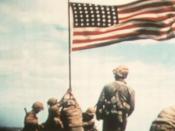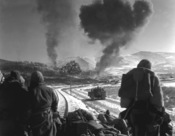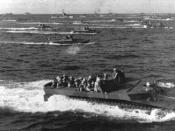The end of WWI meant big change for the Marine Corp. The way the Marine Corp was organized, her mission, and all the doctrine to go along with that mission was introduced and / or changed. The results of the WWII were no the same as WWI. For the large part, the amphibious doctrine developed in the 1930's and early 1940's remained intact throughout the war. However, change was obvious in two other areas. First, innovative technology came out of the pacific campaign. Second, there was refinement in the techniques used to apply the amphibious doctrine. The Marines proved the worth of their amphibious doctrine throughout the war with the Japanese, and showed their adaptive power with new technologies and techniques.
Chief among the technological advancements was the LVT, or alligator. Originally designed as a logistical tool, they were adapted to be used by the infantry at Tarawa, where their rugged tracked design gave them an advantage in crossing the reefs.
Later in the central pacific, specifically Iwo Jima, these machines were fitted with machine guns, rockets and howitzers to lead the first wave of troops ashore. Other technological advances came in the field of communications. As a result of the Tarawa communications breakdown, specially designed amphibious headquarters ships were designed and employed, with many advanced types of communications. Additionally, improvements were made on existing types of radios, making them more lightweight and waterproof. This greatly helped to improve ship-to-shore communications during the most critical time, the assault phase.
Additionally, advancements were made in the ways these new technologies were applied to the fight. Specifically, techniques in war fighting were advanced and refined in order to meet the unique situations often found in the central pacific. The biggest examples of these refinements were in supporting arms, close air support,



USMC.
This is a good informative paper but I believe that you should be writing "Marine Corps" instead; the 's' is silent.
1 out of 1 people found this comment useful.